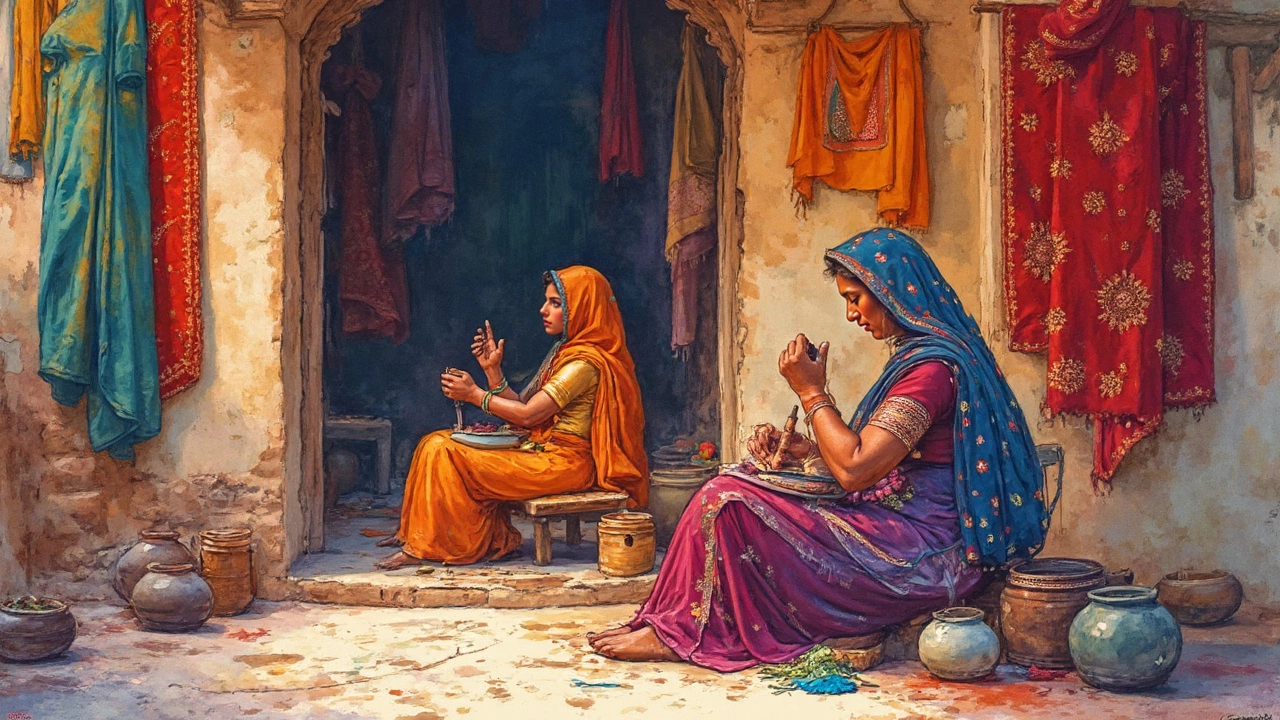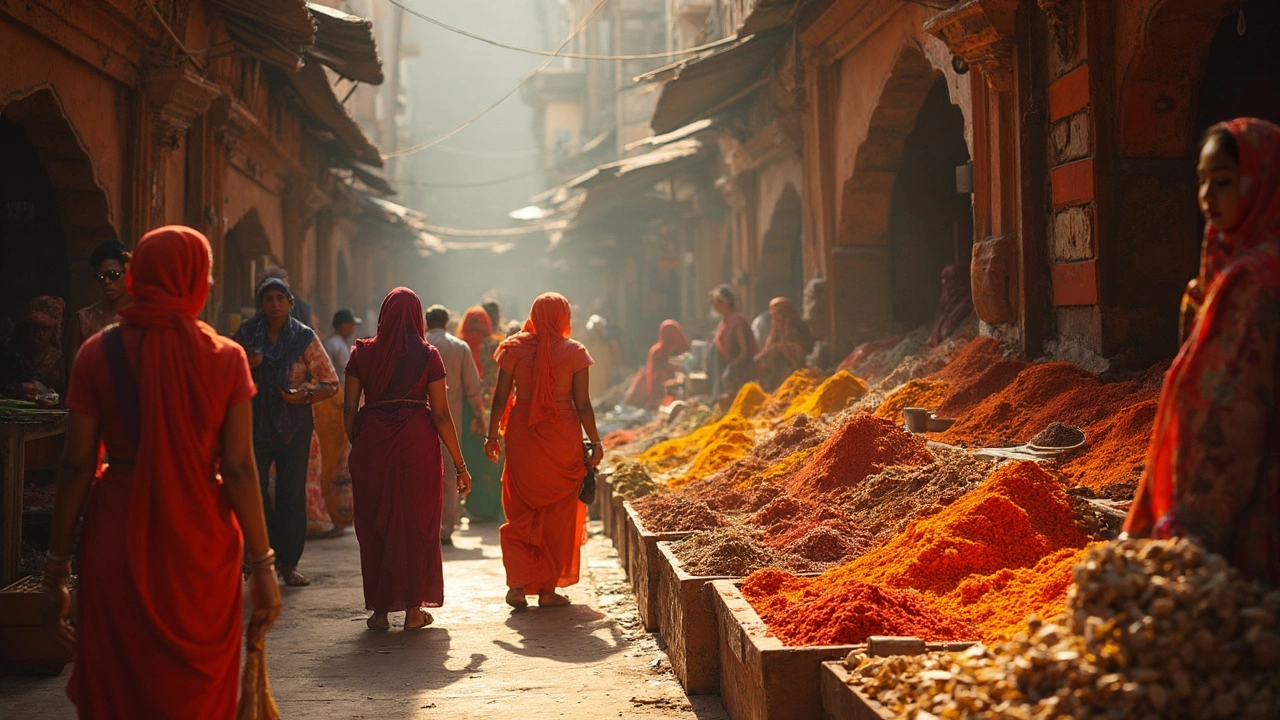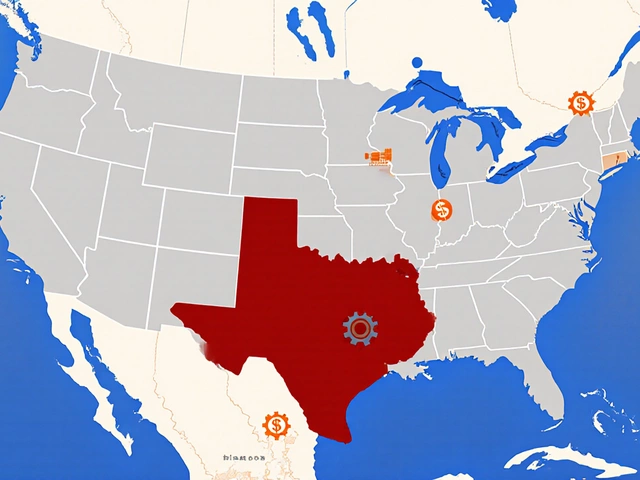You ever notice how your morning chai tastes a little different when it's made with Indian tea? Or how that soft, lightweight cotton shirt feels just right on your skin? India is not just a country of big festivals and even bigger families—it's an engine room for products that pop up in cupboards, wardrobes, and digital devices all over the world. People might recognize Bollywood or cricket first, but wait till you see the mind-boggling list of things India churns out by the truckload. Some of these will surprise you. India has literally redefined the game for what the world uses, tastes, wears, and codes. Ready to peek into what really comes out of this ancient, endlessly inventive land? Strap in.
Spices and Food Staples: The Seasoning of the World
Open your kitchen cabinet and you'll likely see at least one spice that India produces. No one does it like they do in spice country—India single-handedly exports about 75% of the world’s spices. Black pepper, cardamom, cumin, turmeric, coriander, chili powder—the country is the undisputed world leader. You know that golden turmeric latte at your local café? That bright yellow probably came from a farm in Kerala or Andhra Pradesh. Not just spices, India is a rice powerhouse too, especially with basmati. That fluffy rice on your plate at a fancy Indian restaurant? There’s a good chance it comes from paddy fields running alongside the Himalayan foothills.
But that’s just the start. India supplies nearly a quarter of the world’s pulses—lentils, chickpeas, pigeon peas, and mung beans are everyday fare in Indian homes and now in vegan kitchens worldwide. If you’re into healthy eating, chances are you’ve eaten something grown in Indian soil. Toss in the fact that India is also the world’s largest producer of milk, with stats so crazy that it produced 233 million tons of milk in 2023 (thanks to the humble buffalo and millions of small-scale farmers). Not even kidding, the dairy here is its own economy. Families like mine grow up drinking milk from a guy who shows up every morning with a steel canister balanced expertly on his bike.
Here's a quick look at the numbers:
| Product | Global Rank | Production Volume (2023) |
|---|---|---|
| Spices | 1st | ~2 Million Metric Tons |
| Rice (Basmati) | 1st (Basmati) | 52 Million Metric Tons |
| Pulses | 1st | 27 Million Metric Tons |
| Milk | 1st | 233 Million Metric Tons |
And if you’re ever in an Indian grocery store, don’t miss ghee. This technique of clarifying butter is so woven into local cooking that it’s now everywhere from New York bakeries to London brunch counters. If you’re an ice-cream fan, take a careful look at packaging: Amul, an age-old Indian dairy giant, exports several surprising frozen treats straight from Gujarat.
Textiles: From Cotton to Stunning Sarees
If there’s one thing every Indian household, including mine, celebrates—it’s good fabric. India doesn’t just fill closets; it weaves tradition, pride, and business into every thread. With its long history as the birthplace of cotton cloth (no joke, Indian cotton was being traded with Egypt and Rome more than 2000 years ago), India still remains the world’s top cotton producer. That stuff you see tagged as “100% Indian cotton” in stores in the US and Europe? Authentic, soft, and designed to survive more summers than you’d expect.
Yet, Indian textiles aren’t just about simple T-shirts. India is a treasure trove of regional handlooms and crafts. Think vibrant, hand-printed block prints from Rajasthan, shiny silk sarees from Varanasi, pashmina shawls from Kashmir (try not to gasp at the feel), and intricate embroidery that decorates everything from wedding dresses to luxury pillow covers. Families pass down sarees and shawls as heirlooms. The designs change state by state, but the wow factor stays the same.
India supplies a chunk of the global market’s home linens—bedsheets, towels, curtains, you name it. Walk into a high-end hotel in Dubai or Singapore, and the linens could have journeyed all the way from Coimbatore. The country’s textile exports hit nearly $44 billion in 2023—enough fabric to circle the earth three times (okay, a rough guess, but you get the scale).
- Indian cotton exports feed major brands in Japan, Turkey, and China.
- Handmade khadi is experiencing a renaissance, popular with both local youth and eco-conscious buyers in the West.
- Kanchipuram silk sarees can cost as much as a small car and are worn on the biggest occasions.
- The sari industry by itself supports millions of weaver families.
If you want a life hack for travel: buy local handloom goods when you visit. Not only are you supporting crafts that have survived centuries, but you’ll own a piece of living history.

Jewels, Gems, and Minerals: India’s Sparkling Side
Sparkling jewels are not just for Bollywood stars or wedding season show-offs. India’s fascination with gems goes back a few millennia. It once was virtually the only diamond source on earth until South America’s mines came into the picture. Now, 9 out of 10 diamonds in global jewelry stores have actually been cut and polished in Surat, Gujarat. The city buzzes 24/7 with nearly a million diamond artisans, making it the world’s real diamond capital, even if most folks don’t realize it.
Gold is woven into every big life event here—marriages, births, you name it. While India isn’t the top gold miner, it’s the largest gold consumer, importing more than 800 tons each year. The shine isn’t just about gold and diamonds. Silver anklets (payals), precious stones, and intricate filigree work bring old traditions to new-age fashionistas.
India’s mineral scene is equally wild. The country is a top-5 global producer of iron ore, mica, and bauxite. If you’re looking at an old makeup compact, there’s a good chance the shimmer comes from Indian mica. Car and smartphone manufacturers worldwide rely on these raw materials shipped straight from Indian mines.
Actual gem trade stats look like this:
| Product | World Rank | Export Value (2023) |
|---|---|---|
| Cut & Polished Diamonds | 1st | $24 Billion |
| Gold Consumption | 1st | ~850 Tons Imported |
| Mica | 1st | 1.9 Million Tons |
| Iron Ore | 5th | $3.5 Billion |
Rings, watches, luxury cars—India’s minerals and gem experts make the global luxury market tick. If you ever ask my kid, Kian, what his favorite festival is, he'd shout "Diwali!" and then ask if he can try on his grandma’s gold bangles. The love for sparkle is truly passed down here.
Innovation: Tech, Digital Services, and Pharma Giants
People still picture crowded bazaars and ancient temples, but India quietly runs much of the world’s back offices and software labs. Every day, American and European companies rely on code written in Bengaluru, Hyderabad, and Pune for their banking, hospital systems, and shopping apps. India is the world’s largest exporter of IT services. Ever interacted with a tech-support call center? There’s a solid chance you talked to someone sipping chai on the other side of the planet.
Bigger still is the way Indian brains are changing innovation. Tech entrepreneurs are launching companies that revolutionize payment systems, learning apps, and everything in between. The Unified Payments Interface (UPI), for example, processed nearly 100 billion transactions in 2023 alone—making it the largest such ecosystem in the world. Meanwhile, Indian pharmaceutical companies are now top suppliers of generic drugs—supplying about 20% of the world’s generic medicines. During emergencies like the pandemic, India was the primary supplier of vaccines to entire continents. It goes way beyond cheap labor—it’s about scale, skill, and being everywhere at once.
Here’s a quick tech and pharma snapshot:
| Sector | Global Impact | Known For |
|---|---|---|
| IT/BPO | 1st (exports) | Software development, technical support |
| Pharma | Top 3 (globally) | Generic drugs, vaccines |
| Fintech | Top 5 (usage) | UPI payments, digital wallets |
Even astronauts are riding Indian rockets—ISRO, the national space agency, recently launched a moon mission on a fraction of the US budget. Every young coder here dreams of building the next big app, and the country births more engineers every year than the population of some European countries.
- India’s "Silicon Valley" (Bengaluru) is home to over 4,000 tech startups.
- The number of annual STEM graduates tops 2 million, second only to China.
- India’s combination of tech skills and creative hustle makes it the ultimate software partner.
Kian, even at age 8, wants to "build robots"—and trust me, half his classmates do too. These dreams aren’t just kid fantasies anymore; the tech scene here makes them real, fast.

Hidden Treasures: Films, Crafts, and Fun Facts
Now, here’s a twist—not every “product” fits in a shipping container or gets a customs stamp. India is the world’s largest film producer, with Bollywood alone making over 1,500 movies a year. That’s more than Hollywood and Nollywood combined. Families like mine actually gather more for a movie night than a soccer match (unless it’s cricket season, of course).
The creative pulse doesn’t stop there. Traditional musical instruments—think tablas, sitars, harmoniums—are exported to musicians in almost every jazz and classical fusion band on the planet. Folk art like Madhubani or Warli has now moved from village homes to city art galleries in Paris and New York. Brassware from Moradabad fills souvenir shops in Japan. Leather goods from Kanpur end up in fancy boutiques in Milan and Madrid.
Here are some fun, lesser-known productions:
- Mangoes: India is the number one mango producer. If you haven’t tried an Alphonso, trust me—you haven’t really had a mango.
- Ayurvedic Products: Indian wellness wisdom is now global. From natural oils to home remedies, Ayurveda is a serious business here.
- Tea: Besides spices, Indian tea (Assam, Darjeeling, Nilgiri) is famous from Tokyo to Toronto.
- Yoga Mats: With yoga fever rising, Indian-made mats and accessories are huge exports.
- Sporting Goods: The cricket bats used in the IPL and even in London are made in cities like Meerut.
Flip through your backyard barbecue gear, and you may find cast iron pans stamped “Made in India.” The range is endless—jute bags, hand-painted pottery, even eco-friendly sanitary napkins are catching on in export markets. It’s the little inventions and creative hacks, born from real-life necessity here, that keep catching on abroad.
So, next time you dunk a teabag, wrap up in a cotton sheet, watch an Indian movie, or rely on your asthma inhaler—remember, a bit of India’s creative pulse has crossed oceans to reach you. That’s the real magic behind what India is famous for producing.






